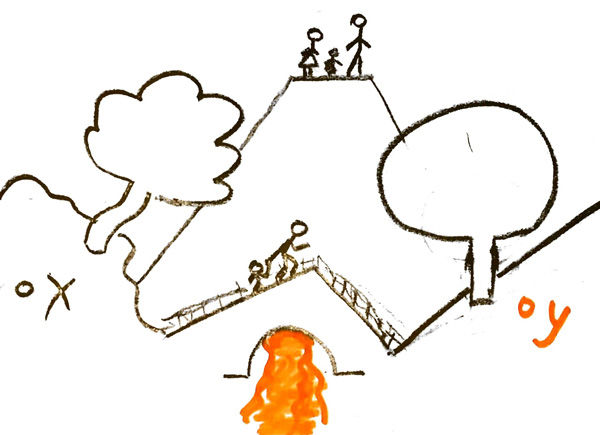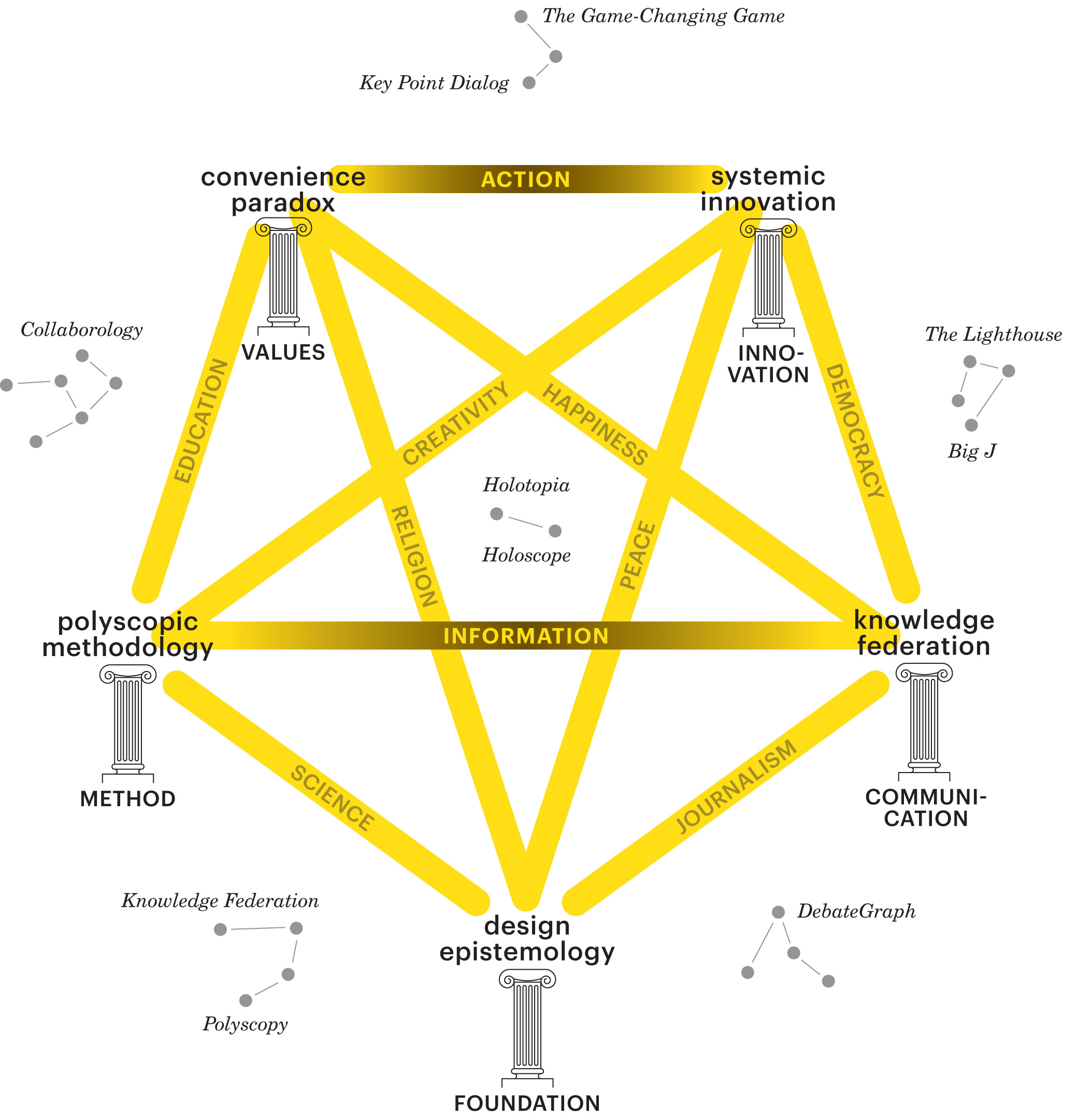Difference between revisions of "N-ideograms"
m |
m |
||
| Line 3: | Line 3: | ||
<div class="row"> | <div class="row"> | ||
<div class="col-md-3"><font size="+1"><em><b>Ideograms</b></em> render "one thousand words" as "a picture".</font></div> | <div class="col-md-3"><font size="+1"><em><b>Ideograms</b></em> render "one thousand words" as "a picture".</font></div> | ||
| − | <div class="col-md-7"><h3>Ideograms help us | + | <div class="col-md-7"><h3>Ideograms help us see things whole.</h3> |
<p> Aurelio Peccei summed up in <em>One Hundred Pages for the Future</em>: | <p> Aurelio Peccei summed up in <em>One Hundred Pages for the Future</em>: | ||
“The arguments posed in the preceding pages […] point out several things, of which one of the most important is that our generations seem to have lost the sense of the whole. From all points of view, this loss represents a backward step, an unfortunate involution—especially since it has occurred at the very moment when many systems, old and new, are expanding and intertwining, thus deepening the complexity of the great metasystem of the world which gives humanity, willy-nilly, a substantial unity. A sense of the global and universal harmony, which is characteristic to philosophical and religious thought and is the eternal quest of science, has also become an indispensable basis for informed political action. That sense must be restored to present-day society.”</p> | “The arguments posed in the preceding pages […] point out several things, of which one of the most important is that our generations seem to have lost the sense of the whole. From all points of view, this loss represents a backward step, an unfortunate involution—especially since it has occurred at the very moment when many systems, old and new, are expanding and intertwining, thus deepening the complexity of the great metasystem of the world which gives humanity, willy-nilly, a substantial unity. A sense of the global and universal harmony, which is characteristic to philosophical and religious thought and is the eternal quest of science, has also become an indispensable basis for informed political action. That sense must be restored to present-day society.”</p> | ||
| Line 22: | Line 22: | ||
<p>How could such an uncanny error <em>ever</em> be made? Certainly the people who created this strange vehicle never even <em>considered</em> the options—simply <em>adopted</em> the source of illumination they already had—which had been created for a <em>different</em> function; with out-of-date technology. </p> | <p>How could such an uncanny error <em>ever</em> be made? Certainly the people who created this strange vehicle never even <em>considered</em> the options—simply <em>adopted</em> the source of illumination they already had—which had been created for a <em>different</em> function; with out-of-date technology. </p> | ||
| − | <p> | + | <p> In <em>One Hundred Pages for the Future</em>, in 1981, based on a decade of The Club of Rome’s research into the future prospects of mankind, Aurelio Peccei—this global think tank’s leader and co-founder—concluded: “It is absolutely necessary to find a way to change course.”</p> |
| − | + | <h3>Changing the 'headlights' is <em>the</em> natural way to "change course".</h3> | |
| − | + | <p> In his 1969 MIT report and call to action—to institute a <em><b>transdiscipline</b></em>—Erich Jantsch quoted Norbert Wiener, the iconic progenitor of cybernetics:</p> | |
| − | |||
| − | |||
| − | |||
| − | |||
| − | |||
| − | |||
| − | |||
| − | |||
| − | |||
| − | <h3>Changing the 'headlights' | ||
| − | <p> In his 1969 MIT report and call to action—to institute | ||
<p> “There is only one quality more important than ‘know-how’…… This is ‘know-what’ by which we determine not only how to accomplish our purposes, but what our purposes are to be.”</p> | <p> “There is only one quality more important than ‘know-how’…… This is ‘know-what’ by which we determine not only how to accomplish our purposes, but what our purposes are to be.”</p> | ||
<p>Academic disciplines <em>cannot</em> provide us know-what; and the media informing, such as it is, won't do it either. A <em><b>system</b></em> that provides us <em><b>knowledge</b></em> about any of the core themes of our lives and times must <em>combine</em> disciplinary and other evidence; it must <em>transcend</em> academic and cultural fragmentation; it must <em>communicate to the public</em> with the authority of science—in ways that are well beyond the modalities of outreach that the sciences have been able to produce.</p> | <p>Academic disciplines <em>cannot</em> provide us know-what; and the media informing, such as it is, won't do it either. A <em><b>system</b></em> that provides us <em><b>knowledge</b></em> about any of the core themes of our lives and times must <em>combine</em> disciplinary and other evidence; it must <em>transcend</em> academic and cultural fragmentation; it must <em>communicate to the public</em> with the authority of science—in ways that are well beyond the modalities of outreach that the sciences have been able to produce.</p> | ||
Revision as of 09:27, 26 October 2023
Contents
Federation through Ideograms
Ideograms help us see things whole.
Aurelio Peccei summed up in One Hundred Pages for the Future: “The arguments posed in the preceding pages […] point out several things, of which one of the most important is that our generations seem to have lost the sense of the whole. From all points of view, this loss represents a backward step, an unfortunate involution—especially since it has occurred at the very moment when many systems, old and new, are expanding and intertwining, thus deepening the complexity of the great metasystem of the world which gives humanity, willy-nilly, a substantial unity. A sense of the global and universal harmony, which is characteristic to philosophical and religious thought and is the eternal quest of science, has also become an indispensable basis for informed political action. That sense must be restored to present-day society.”
Modernity ideogram
The Modernity ideogram depicts our society as a bus and our information as its candle headlights.
How could such an uncanny error ever be made? Certainly the people who created this strange vehicle never even considered the options—simply adopted the source of illumination they already had—which had been created for a different function; with out-of-date technology.
In One Hundred Pages for the Future, in 1981, based on a decade of The Club of Rome’s research into the future prospects of mankind, Aurelio Peccei—this global think tank’s leader and co-founder—concluded: “It is absolutely necessary to find a way to change course.”
Changing the 'headlights' is the natural way to "change course".
In his 1969 MIT report and call to action—to institute a transdiscipline—Erich Jantsch quoted Norbert Wiener, the iconic progenitor of cybernetics:
“There is only one quality more important than ‘know-how’…… This is ‘know-what’ by which we determine not only how to accomplish our purposes, but what our purposes are to be.”
Academic disciplines cannot provide us know-what; and the media informing, such as it is, won't do it either. A system that provides us knowledge about any of the core themes of our lives and times must combine disciplinary and other evidence; it must transcend academic and cultural fragmentation; it must communicate to the public with the authority of science—in ways that are well beyond the modalities of outreach that the sciences have been able to produce.
Information ideogram

At the risk of oversimplifying, we may now re-introduce knowledge federation as a way to correct the perspective and acquire a correct gestalt.
The Information ideogram points to the structure of the information that knowledge federation aims to produce – which we call information holon. Metaphorically, it points to the principle of operation of the 'light bulb'.
The “i” in this image (which stands for "information") is composed of a circle on top of a square. Think of the square as providing the perspective; and of the circle as depicting the gestalt.
The square stands for the technical and detailed low-level information. The square also stands for examining a theme or an issue from all sides. The circle stands for the general and immediately accessible high-level information. This ideogram posits that information must have both.
Point: information holon is a whole in itself and part in a larger holon. The point is to create information as a holarchy—symbolized by the mountain; and rise above the information jungle; and see where the roads lead and which one we need to follow.
The knowledge federation transdiscipline is a complete prototype of the socio-technical 'lightbulb'.
And that without the former, without the 'dot on the i', the information is incomplete and ultimately pointless.
This ideogram also suggests how to establish or justify the high-level views – by founding them on low-level ones. And by 'rounding off', by 'cutting corners'.
Knowledge Federation ideogram
In Autobiographical Notes Albert Einstein shared his "epistemological credo":
“I see on the one side the totality of sense experiences and, on the other, the totality of the concepts and propositions that are laid down in books. […] The system of concepts is a creation of man, together with the rules of syntax, which constitute the structure of the conceptual system. […] All concepts, even those closest to experience, are from the point of view of logic freely chosen posits, just as is the concept of causality, which was the point of departure for [scientific] inquiry in the first place.”
The Knowledge Federation ideogram comprises the realm of experience or "the real world" on its left, and the realm of ideas or "the concepts and propositions that are laid down in books"on its right; and there's also a bridge that joins those two sides, and a mountain with some stickmen in its background.
We may begin to federate knowledge by looking at the realm of experience or the practical world from the mountain top; and identify a theme—any theme—that demands attention; and then take this theme over the bridge to the realm of ideas, along with other experiences or data that provide it a suitable context, and theorize it and comprehend it; and then take the result back over the bridge and act in an informed way.
The bridge is what makes this possible; it stands for the (general-purpose) methodology, which—unlike the methods provided by the sciences—can be applied freely to any theme of choice.
The mountain stands for abstraction; it empowers us to structure knowledge; and then use it to rise above the information jungle and see where the roads lead; and which one should be followed.
Science gave us "Newton's laws" and other "laws of nature"; and empowered us to comprehend the nature by resorting to simple insights and principles. The aim of knowledge federation is to empower us to comprehend and handle all themes that matter in the manner we can rely on.
"The Matrix is the world that has been pulled over your eyes to blind you from the truth", Morpheus told Neo; to introduce him to the dystopian vision that The Matrix epitomized. As long as we have no other frame of reference than the world itself—we can only adapt to the world; no matter how absurd and dysfunctional it may have become. It is only when we have an independent reference system that we become capable of improving the world.
Holotopia ideogram
The Holotopia ideogram comprises five pillars representing holotopia's five insights; which resulted when I applied the procedure I've just described to five judiciously choose or pivotal themes or categories. The five ihnsights show:
When we'll have knowledge about life's core themes—we'll comprehend and handle them in entirely different ways than we do.
When other themes—including creativity, religion, education, happiness and politics—are considered in the context of the five insights, they too are comprehended and handled in entirely new ways; the Holotopia ideogram features also the ten themes, which demonstrate that.
The stars in this ideogram represent prototypes; and point to the fact that when we collectively elevate ourselves above "the world" and see it differently—we'll also become capable of improving it and even re-creating it; by acting in an informed way.



